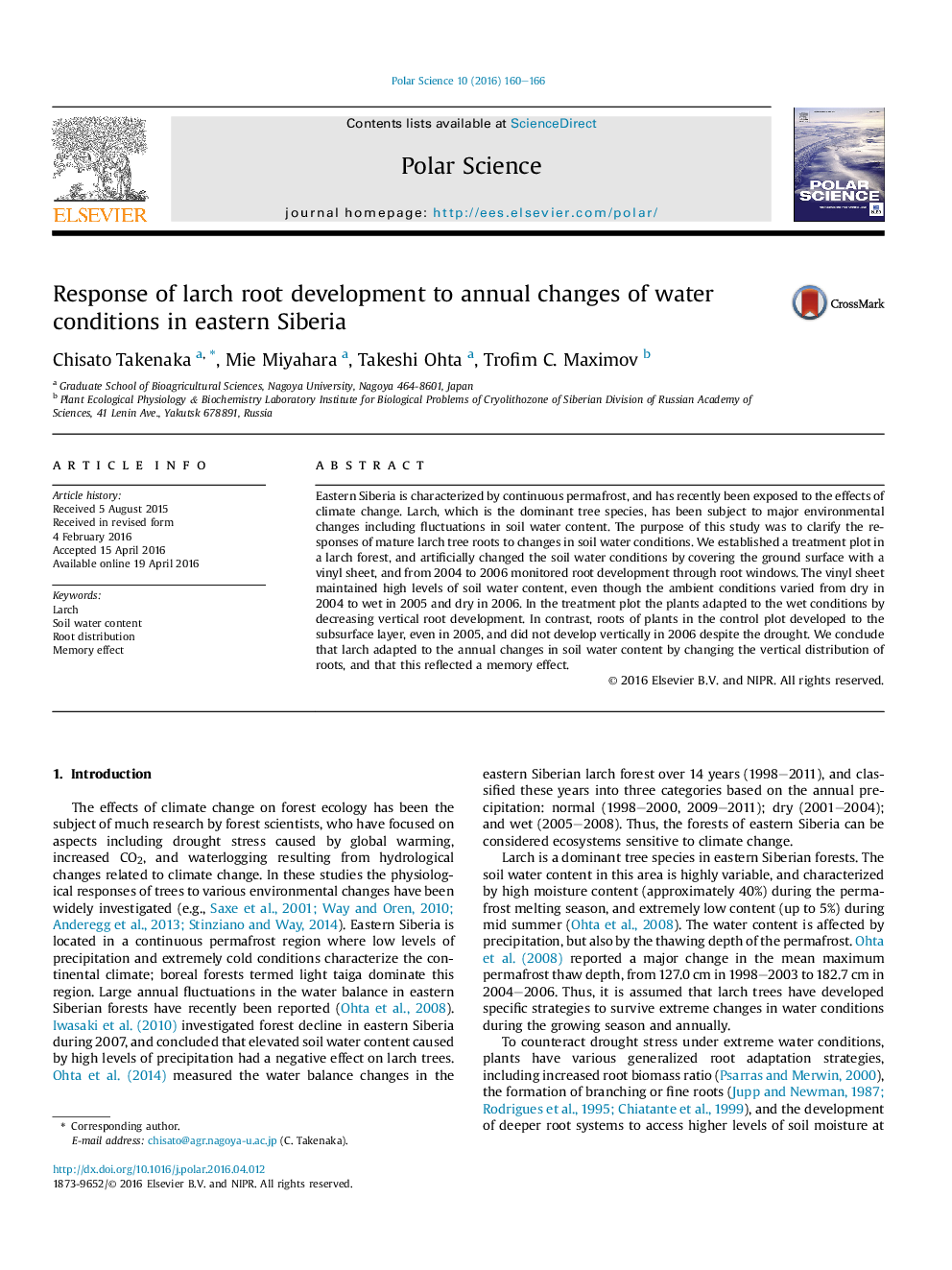| کد مقاله | کد نشریه | سال انتشار | مقاله انگلیسی | نسخه تمام متن |
|---|---|---|---|---|
| 4683158 | 1349279 | 2016 | 7 صفحه PDF | دانلود رایگان |
عنوان انگلیسی مقاله ISI
Response of larch root development to annual changes of water conditions in eastern Siberia
ترجمه فارسی عنوان
پاسخ رشد ریشه داران به تغییرات سالانه شرایط آب در شرق سیبری
دانلود مقاله + سفارش ترجمه
دانلود مقاله ISI انگلیسی
رایگان برای ایرانیان
کلمات کلیدی
کاج محتوای آب خاک، توزیع ریشه، اثر حافظه،
ترجمه چکیده
سیبری شرقی از نظر مماس فروتن مستمر و به تازگی تحت تأثیر تغییرات اقلیمی قرار گرفته است. کاج، که گونه های درخت غالب است، به تغییرات زیست محیطی عمده ای از جمله نوسانات در محتوای آب خاک منجر شده است. هدف از این مطالعه، تعیین پاسخ گیاهان ریشه درختان بالغ به تغییرات شرایط آبی خاک است. ما یک طرح درمان را در یک جنگل کاشته شده درخت کاج تاسیس کردیم و از طریق پوشش سطح زمین با ورق وینیل مصنوعی شرایط آب خاک را تغییر دادیم و از سال 2004 تا 2006 ریشه ها را از طریق پنجره های ریشه کنترل کردیم. ورق وینیل سطح بالای آب خاک را حفظ کرد، هرچند شرایط محیط از سال خشکشده سال 2004 تا مرطوب در سال 2005 و خشک شدن در سال 2006 تغییر کرد. در طرح تداخل، گیاهان با کاهش ریشه عمودی به شرایط خیس تبدیل شدند. در مقابل، ریشه گیاهان در طرح کنترل به لایه زیر سطحی حتی در سال 2005 توسعه یافت و در سال 2006 به رغم خشکسالی به صورت عمودی توسعه نیافت. ما نتیجه گرفتیم که کاشت سبز با تغییر دادن توزیع عمودی ریشه ها با تغییرات سالانه در محتوای آب خاک سازگاری دارد و این امر اثر حافظه را منعکس می کند.
موضوعات مرتبط
مهندسی و علوم پایه
علوم زمین و سیارات
علوم زمین و سیاره ای (عمومی)
چکیده انگلیسی
Eastern Siberia is characterized by continuous permafrost, and has recently been exposed to the effects of climate change. Larch, which is the dominant tree species, has been subject to major environmental changes including fluctuations in soil water content. The purpose of this study was to clarify the responses of mature larch tree roots to changes in soil water conditions. We established a treatment plot in a larch forest, and artificially changed the soil water conditions by covering the ground surface with a vinyl sheet, and from 2004 to 2006 monitored root development through root windows. The vinyl sheet maintained high levels of soil water content, even though the ambient conditions varied from dry in 2004 to wet in 2005 and dry in 2006. In the treatment plot the plants adapted to the wet conditions by decreasing vertical root development. In contrast, roots of plants in the control plot developed to the subsurface layer, even in 2005, and did not develop vertically in 2006 despite the drought. We conclude that larch adapted to the annual changes in soil water content by changing the vertical distribution of roots, and that this reflected a memory effect.
ناشر
Database: Elsevier - ScienceDirect (ساینس دایرکت)
Journal: Polar Science - Volume 10, Issue 2, June 2016, Pages 160-166
Journal: Polar Science - Volume 10, Issue 2, June 2016, Pages 160-166
نویسندگان
Chisato Takenaka, Mie Miyahara, Takeshi Ohta, Trofim C. Maximov,
